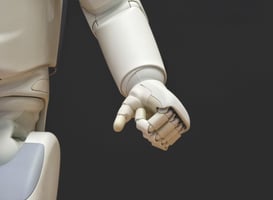Collaborative robots (“cobots”) is the fastest growing segment in industrial automation. Cobots...
The Race to Mars
Charles Bolden, a former space shuttle commander and National Aeronautics and Space Administration (“NASA”) Administrator from 2009 to 2017, dreamed of being the first person on Mars when he first checked in for astronaut training in 1980. At the time, NASA thought that a crewed Mars mission was thirty years away. Of course, we know now that prediction was overly optimistic. Yet there have been technological advancements and a renewed interest in human exploration of the Red Planet recently. For example, SpaceX tested its newest ship that can carry as many as 100 “colonists” to Mars and the U.S., the UAE and China have launched satellites to there. Here, we explore some emerging technologies to support a Mars mission and the fringe benefits of the new space race for us Earthlings.
To begin, let’s “get to know” our red neighbor a bit better. The planet’s name comes from the Roman god of war because of its red, blood-like hue. In fact, all planets in our solar system were named for Greek or Roman gods except Earth (Earth” is an old Germanic word meaning “ground”). The ancient Greeks named the planet “Ares” after their war god, the Chinese called it "the fire star,” and the Egyptians, "Her Desher," which means "the red one."
Humans’ fascination with Mars began with “naked-eye” observation, not with a telescope. The earliest mention of the planet is in ancient Egyptian hieroglyphics. The tomb of Pharaoh Seti I, who died around 1279 B.C., had a depiction of the planet. As early as 1045 B.C., Chinese astronomers were recording its movement in the firmament. About 300 years later, Babylonian astronomers, who associated Mars with the war god, Negral, began keeping detailed accounts of its planetary movement. Plato included a mention of Mars in The Republic (circa 380 B.C). Galileo Galilei (1564-1642) is believed to have been the first to explore the planet through a telescope, though he could not discern the surface features. It was not until 1659 that Dutch astronomer, Christian Huygens, first illustrated the Martian topography.
Some “facts at a glance” about Mars:
- Radius: 2,106 miles
- Surface area:91 million sq. miles
- Orbital distance:63 million miles
- Orbital order in the solar system: 4
- Orbital period:97 days
- Gravity:71 m/s² (the acceleration of an object falling freely due to gravity)
- Color: Red from prevalent iron oxide on the surface
- Average Surface Temperature: -55° C
- Extreme Polar Temperature: -153° C
- Atmosphere: Carbon dioxide (95.32%), molecular nitrogen (2.6%), argon (1.9%) and trace levels of water vapor, oxygen, carbon monoxide, and hydrogen.
- Surface Pressure: 610 Pascals (0.088 psi), which is less than 1% of the Earth's.
Despite the distance and other differences between Earth and Mars, NASA believes that a manned launch there is clear, affordable, and sustainable, though it will require technical and special equipment beyond any space mission so far – specifically, advancements in artificial intelligence (“AI”), recycling and sustainability, sensor technology, radiation protection, and prevention of muscle degeneration and osteoporosis due to the gravitational difference. These advancements certainly will have benefits for life on Earth. For example, NASA has determined that a human will have input for scheduling and problem-solving, while AI would do the “heavy lifting” as an “amplifier” of decision-making. As a result of a manned mission to Mars, we can expect better infrastructures to support more complex decision-making faster and with more accuracy. Improvements in recycling and sustainability technology that must address the astronauts’ need to “live off the land” and to recycle material in a closed system will help countries explore ways to reduce carbon emissions, increase the use of recyclable containers, and improve farming techniques and yield and even to introduce terraforming to harsh and otherwise uninhabitable places on Earth.
With the returning spacecraft passing through high radiation and reaching temperatures of 4,000 degrees Fahrenheit at a re-entry speed of 20,000 miles per hour, fully-functioning sensors are critical to detect crew cabin conditions. These advancements in sensor technology have an enormous potential to improve manufacturing, healthcare (diagnosing and monitoring health), smart cities’ capabilities, and workplace safety. Further, exposure to radiation during the trip to and from Mars presents a significant challenge. Scientific discovery of ways to reduce astronaut radiation exposure could have many applications for the cosmetic, healthcare, and construction industries. Methods to reduce osteoporosis and muscle degeneration due to the gravitational difference could lead to proactive steps people can take to avoid these problems, treatment for existing conditions, advancements in sports medicine, and better exercise equipment/facilities.
As past missions to space have spawned the development of computerized tomography (CT) scanners, satellite television, freeze-dried food, Teflon, and cordless tools, manned missions to Mars hold even greater potential for positive impacts to our environment, our well-being, and the global economy.



